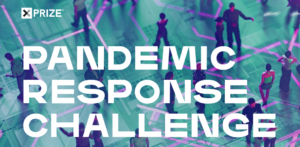
XPRIZE Seeks AI That Balances COVID-19 Containment, Economic Impact

Half a million dollars are up for grabs in the latest XPRIZE competition, which pits dozens of data science teams against one another to find prescriptive models that contain the spread of COVID-19 without strangling the economy. With coronavirus infections ranging around the world and millions of folks still in lockdown, there’s a lot more at stake than just prize money.
The XPRIZE Pandemic Response Challenge is intended to advance the bounds of knowledge around COVID-19 and give policy-makers better tools to fight the deadly disease, says Babak Hodjat, the vice president of evolutionary AI at Cognizant, the New Jersey-based digital services firm that’s co-hosting the event with XPRIZE and is providing material support for it.
“To be able to tackle COVID, we need to know what’s going to happen next,” Hodjat says. “Early on, we didn’t know anything about the virus. Nothing! We didn’t even know whether, if somebody recovers from COVID, whether they’re going to get it again. We were faced with a lot of unknowns, which do reflect in the data. That’s why I think a data-driven approach should be taken seriously here.”
More than 100 teams from around the world convened virtually in November to compete in the XPRIZE, which was split into two phases. Phase one, which ended in January, involved creating predative models to forecast the spread of COVID-19 across multiple regions, based on an Oxford University reference data set. The top 48 teams from phase one proceeded to phase two, which involved creating prescriptive models that measure the relative effectiveness of COVID-19 interventions.
Phase two, which ended Wednesday, was more challenging because it forced teams to come up with a balance between preventing the spread of the coronavirus while minimizing the economic cost of interventions. The Oxford data set is invaluable here, Hodjat says, because it includes data about the non-pharmaceutical interventions that various regions have taken to prevent the spread, ranging from travel restrictions and business shutdowns to school closings and mask mandates.
“If I’m a country that is in summer and schools are closed anyway, maybe closing schools is easier for me than a region that is in the midst of an education term,” Hodjat says. “The same things goes for travel restrictions. If I’m an island, I can shut down, no problem. But another country with an economy that depends on tourism–they can’t really do that. So the cost that is assigned to different policies is different depending on the region, and these teams have to take that into account in providing their policy recommendations.”
Different Modeling Approaches
The teams were free to use any approach to build their models, and Cognizant and XPRIZE do not impose many restrictions on the teams, aside from the need to actually run the models within a reasonable amount of time. That means teams are free to use a supercomputer to build a simulation of COVID-19 spread, as long as it can actually execute in Cognizant’s sandboxed environment.
Hodjat expects most teams to utilize data-based approaches, including machine learning, but he doesn’t rule out HPC or deep learning. In fact, Cognizant provides its own LSTM neural network model for time-series data as a benchmark for XPRIZE teams to use for their analysis. “We should never discount statistics-based approaches,” Hodjat says. “I tell my team, if you haven’t tried a random forest before you go off and build a deep learning system, that’s just plain wrong.”
One of the XPRIZE competitors who has experimented with traditional machine learning and more advanced AI techniques is Debashis Sahoo, an assistant professor of pediatrics at University of California, San Diego. As the leader of Team Shanvi, Sahoo has participated in XPRIZE competitions before, and was eager to join this new competition to push the state of the art in coronavirus pandemic modeling.
“We focused initially on a more explainable model that is based on regressions and ensemble models,” Sahoo tells Datanami. His team employed a mix of random forest, Gaussian process, and XGBoost models, as well as Bayesian and Boolean techniques. “We tried all of these,” he continues. “We have a reasonable model that seems to be able to predict very well–very close to what the deep learning model actually does.”
Formal Methods
Sahoo is hopeful that his unique approach to modeling will bear fruit in this XPRIZE competition. His secret weapon is the study of formal methods, an area of study for which his advisor, E. Allen Emerson, received a Turing Award in 2007. Very few people in the computer science community work with formal methods, Sahoo says, but he is hopeful that it provides a path to finding universal properties, and therefore prescriptions that are more generalizable and successful.

XPRIZE participants are using AI to model COVID-19 pandemic responses (Tatiana Shepeleva/Shutterstock)
“We are so zoomed into one particular space, so confined with things that we think are generalizable, but are not really,” says Sahoo, who has a PhD in electrical engineering from Stanford University and is the founding director of UCSD’s Boolean Lab. “But with this new perspective of formal methods, we can do that. We have had strong success in the setting.”
Sahoo’s formal method approach yielded the insight that holidays play an outsize role in the spread of coronavirus, which informed its phase-one modeling. In phase two, the non-pharmaceutical intervention that has bubbled to the top of his team’s model is the impact of closing workplaces.
“That’s actually the biggest factor that we see. The workplace was the driver of the pandemic,” Sahoo says. “[Closing workplaces] is a little bit costly for some countries…We’ve been able to come up with a spectrum of different levels of stringency and different levels of prescription that hopefully will be very useful to politicians, to society, to us, to live better during the pandemic.”
Better Living Through Data Science
The event’s creators opted to replicate the real-world conditions that actual epidemiologists work under. By limiting the amount of time and compute resources that teams had available to them, it forced teams to concentrate on the most practical approaches. When the final results come out next month, the hope is that the whole will be greater than the sum of the parts.
“With the limited computation time, you really can’t explore the huge amount of space that his pandemic poses,” Sahoo says. “So all of us are basically exploring a little bit of space. If there’s an elephant, one of us is touching the tail, the other is touching the ear, one of us is touching the feet. We don’t have a big picture yet. We don’t know it’s an elephant. We hope with all of these combined efforts, we will be able to see a better picture of what this pandemic is.”

XPRIZE seeks the COVID-19 model that can best balance protection of health versus economic harm (Andy-Dean-Photography/Shutterstock)
With any luck, the prescriptive models that XPRIZE competitors come up with will give decision-makers better tools for maximizing the impact in preventing COVID-19 from spreading while minimizing the collateral damage to the economy and people’s lives. This is something that has the real potential to benefit society before the pandemic has run its course, Cognizant’s Hodjat says.
“What we’re trying to do is give this tool to a regional authority and say, tell us what balance of economic impact and containment you care about,” he says. “When it comes to economic impact, tell us which one of these polices at what stringency are more important to you? Just rank order them. Once we have that, our system is going to give you the best possible set of advice through time three months from now.”
Related Items:
How Data Can Help Optimize COVID-19 Vaccine Distribution
Algorithm Gets the Blame for COVID-19 Vaccine Snafu
Stanford COVID-19 Model Identifies Superspreader Sites, Socioeconomic Disparities




























